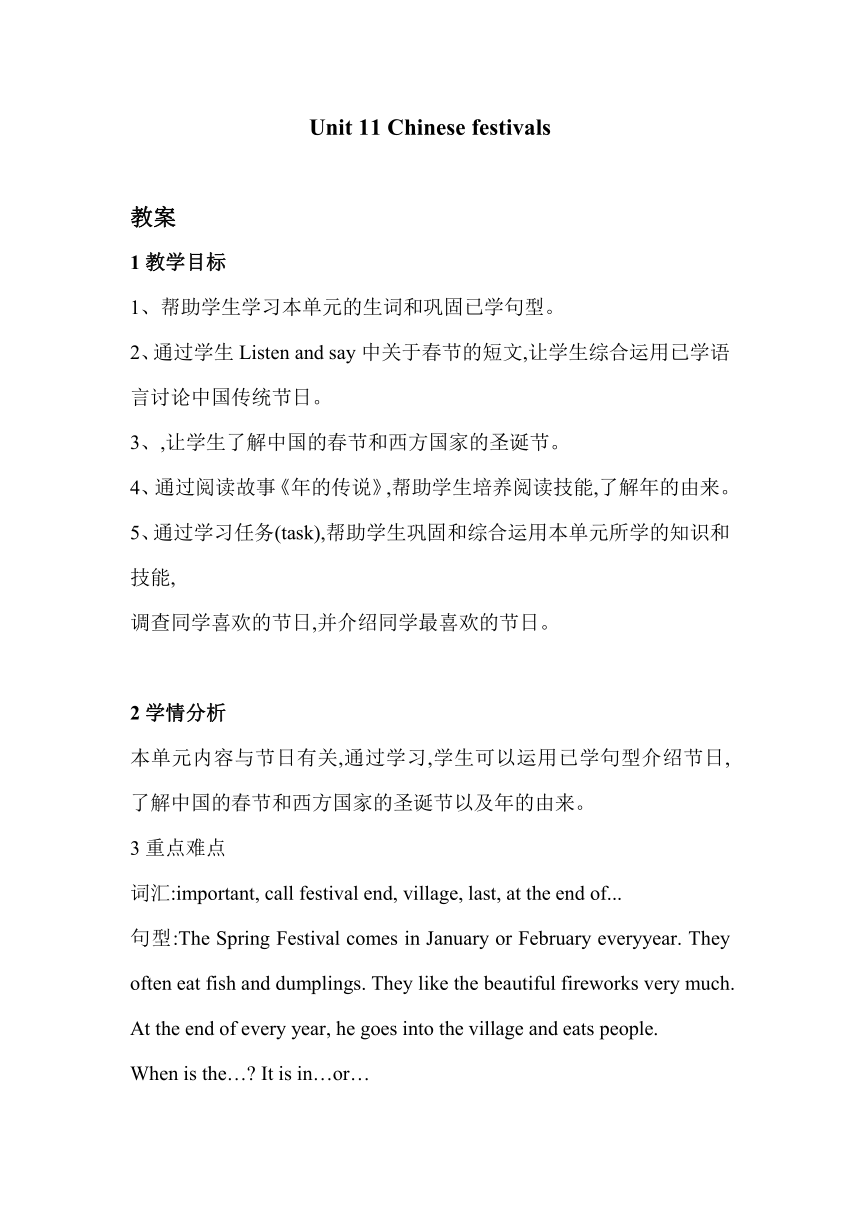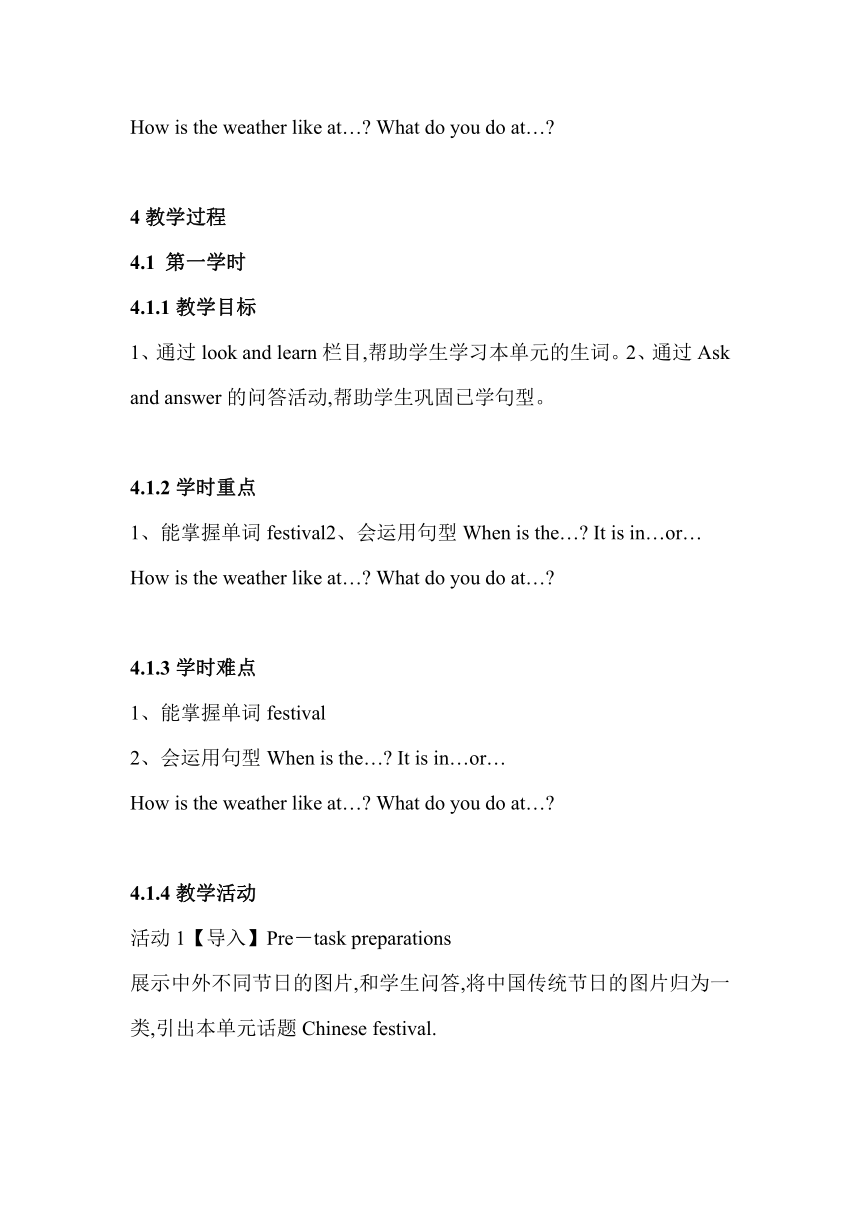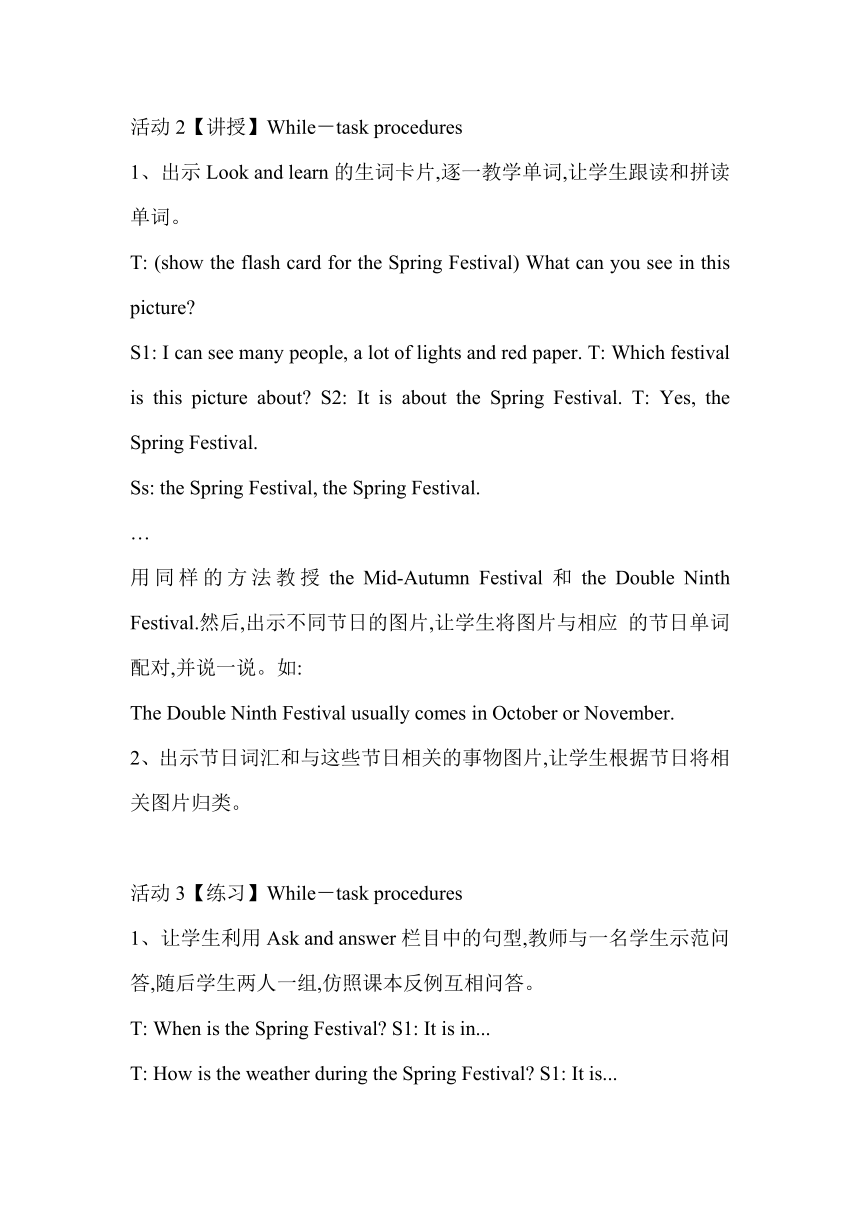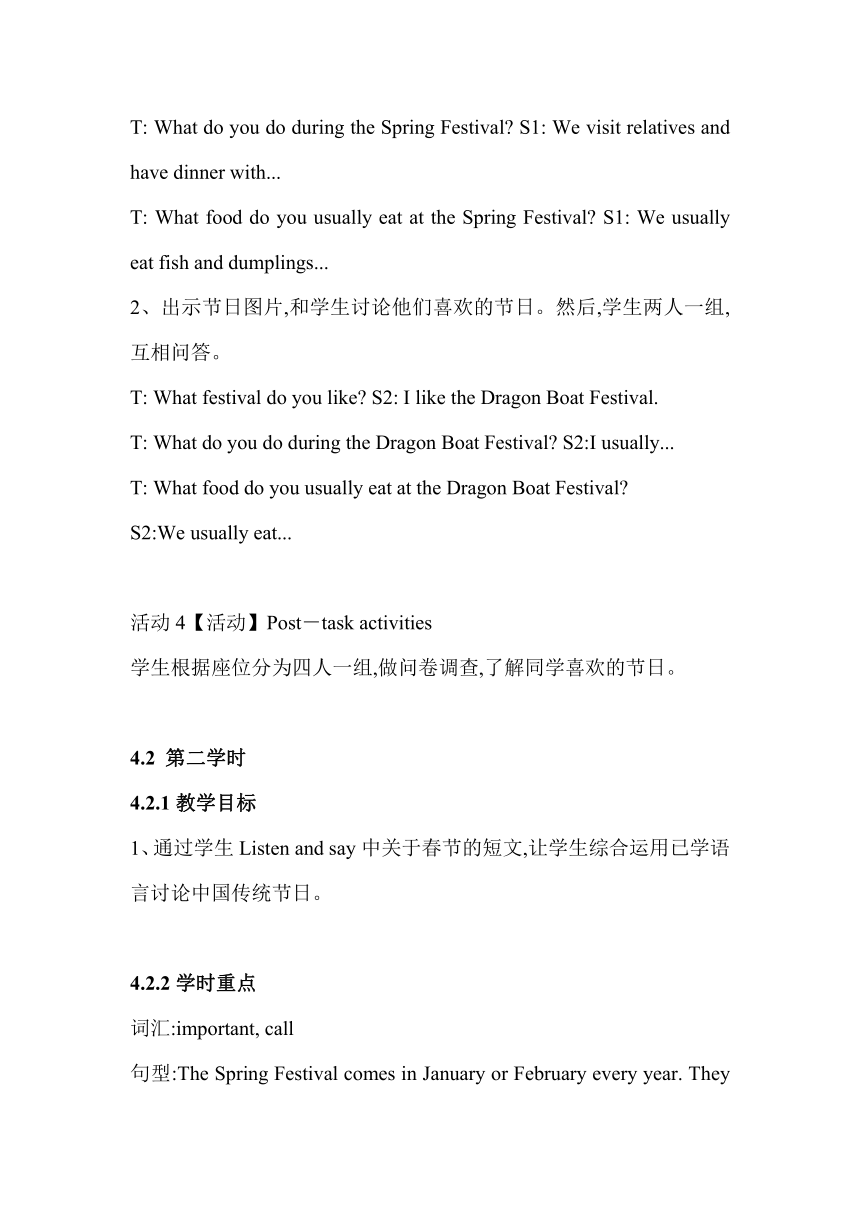Unit 11 Chinese festivals 教案(3个课时)
文档属性
| 名称 | Unit 11 Chinese festivals 教案(3个课时) |  | |
| 格式 | zip | ||
| 文件大小 | 120.1KB | ||
| 资源类型 | 教案 | ||
| 版本资源 | 牛津沪教版 | ||
| 科目 | 英语 | ||
| 更新时间 | 2017-06-16 10:09:10 | ||
图片预览




文档简介
Unit
11
Chinese
festivals
教案
1教学目标
1、帮助学生学习本单元的生词和巩固已学句型。
2、通过学生Listen
and
say中关于春节的短文,让学生综合运用已学语言讨论中国传统节日。
3、,让学生了解中国的春节和西方国家的圣诞节。
4、通过阅读故事《年的传说》,帮助学生培养阅读技能,了解年的由来。
5、通过学习任务(task),帮助学生巩固和综合运用本单元所学的知识和技能,
调查同学喜欢的节日,并介绍同学最喜欢的节日。
2学情分析
本单元内容与节日有关,通过学习,学生可以运用已学句型介绍节日,了解中国的春节和西方国家的圣诞节以及年的由来。
3重点难点
词汇:important,
call
festival
end,
village,
last,
at
the
end
of...
句型:The
Spring
Festival
comes
in
January
or
February
everyyear.
They
often
eat
fish
and
dumplings.
They
like
the
beautiful
fireworks
very
much.
At
the
end
of
every
year,
he
goes
into
the
village
and
eats
people.
When
is
the…
It
is
in…or…
How
is
the
weather
like
at…
What
do
you
do
at…
4教学过程
4.1
第一学时
4.1.1教学目标
1、通过look
and
learn栏目,帮助学生学习本单元的生词。2、通过Ask
and
answer的问答活动,帮助学生巩固已学句型。
4.1.2学时重点
1、能掌握单词festival2、会运用句型When
is
the…
It
is
in…or…
How
is
the
weather
like
at…
What
do
you
do
at…
4.1.3学时难点
1、能掌握单词festival
2、会运用句型When
is
the…
It
is
in…or…
How
is
the
weather
like
at…
What
do
you
do
at…
4.1.4教学活动
活动1【导入】Pre-task
preparations
展示中外不同节日的图片,和学生问答,将中国传统节日的图片归为一类,引出本单元话题Chinese
festival.
活动2【讲授】While-task
procedures
1、出示Look
and
learn的生词卡片,逐一教学单词,让学生跟读和拼读单词。
T:
(show
the
flash
card
for
the
Spring
Festival)
What
can
you
see
in
this
picture
S1:
I
can
see
many
people,
a
lot
of
lights
and
red
paper.
T:
Which
festival
is
this
picture
about
S2:
It
is
about
the
Spring
Festival.
T:
Yes,
the
Spring
Festival.
Ss:
the
Spring
Festival,
the
Spring
Festival.
…
用同样的方法教授the
Mid-Autumn
Festival和the
Double
Ninth
Festival.然后,出示不同节日的图片,让学生将图片与相应
的节日单词配对,并说一说。如:
The
Double
Ninth
Festival
usually
comes
in
October
or
November.
2、出示节日词汇和与这些节日相关的事物图片,让学生根据节日将相关图片归类。
活动3【练习】While-task
procedures
1、让学生利用Ask
and
answer栏目中的句型,教师与一名学生示范问答,随后学生两人一组,仿照课本反例互相问答。
T:
When
is
the
Spring
Festival
S1:
It
is
in...
T:
How
is
the
weather
during
the
Spring
Festival
S1:
It
is...
T:
What
do
you
do
during
the
Spring
Festival
S1:
We
visit
relatives
and
have
dinner
with...
T:
What
food
do
you
usually
eat
at
the
Spring
Festival
S1:
We
usually
eat
fish
and
dumplings...
2、出示节日图片,和学生讨论他们喜欢的节日。然后,学生两人一组,互相问答。
T:
What
festival
do
you
like
S2:
I
like
the
Dragon
Boat
Festival.
T:
What
do
you
do
during
the
Dragon
Boat
Festival
S2:I
usually...
T:
What
food
do
you
usually
eat
at
the
Dragon
Boat
Festival
S2:We
usually
eat...
活动4【活动】Post-task
activities
学生根据座位分为四人一组,做问卷调查,了解同学喜欢的节日。
4.2
第二学时
4.2.1教学目标
1、通过学生Listen
and
say中关于春节的短文,让学生综合运用已学语言讨论中国传统节日。
4.2.2学时重点
词汇:important,
call
句型:The
Spring
Festival
comes
in
January
or
February
every
year.
They
often
eat
fish
and
dumplings.
They
like
the
beautiful
fireworks
very
much.
4.2.3学时难点
词汇:important,
call
句型:The
Spring
Festival
comes
in
January
or
February
every
year.
They
often
eat
fish
and
dumplings.
They
like
the
beautiful
fireworks
very
much.
4.2.4教学活动
活动1【测试】Pre-task
preparations
1、教师和学生就上一课时的小组调查问卷进行问答,复习已学内容。
T:
Which
festival
do
you
like
S1:
I
like
the
Mid-Autumn
Festival.
T:
How
many
boys/girls
like
the
Mid-Autumn
Festival
S1:
Two
boys
and
four
girls
like
the
Mid-Autumn
Festival.
T:
When
is
the
Mid-Autumn
Festival
S1:
It
is
in
September
or
October.
T:
What
do
you
usually
do
at
the
Mid-Autumn
Festival
S1:
I
usually
look
at
the
beautiful
moon
and
eat
moon
cakes.
…
2、要求学生说说自己最喜欢的节日,并说明原因。T:
Please
tell
us
what
your
favourite
festival
is
and
why.教师可以把学生回答的内容一纲要的形式写在黑板上,如:
Festival
activities
The
Spring
Festival
buy
new
clothes
(in
January
or
February)
buy
traditional
food
have
a
big
dinner
eat
dumplings
Visit
friends
and
relatives
get
money
in
red
packets
watch
fireworks
活动2【测试】While-task
procedures
1、借助上一活动的图表,引入Listen
and
say的教学。出示Listen
and
say的图片,同时播放课文录音,让学生看图做选择练习检测学生是否理解课文内容。
1)
The
Spring
Festival
is
a
(
)
festival
in
China.
A.
big
B.
small
C.
new
2)
People
also
call
The
Spring
Festival
(
).
A.
Chinese
Christmas
B.
Chinese
New
Year’s
Eve
C.
Chinese
New
Year
3)
Families
have
a
big
dinner
together
on
(
).
A.
Mother’s
Day
B.
Chinese
New
Year’s
Eve
C.
Children’s
Day
2、让学生读课文,然后回答相关问题。如When’s
the
Spring
Festival
What
do
people
do
at
the
Spring
Festival
根据学生的回答,
让学生说说,介绍春节。
活动3【练习】While-task
procedures
1、根据Listen
and
say的内容,与一名学生进行示范问答,随后让全班学生模仿范例开展对子活动。
T:
Is
the
Spring
Festival
an
important
festival
in
China
S1:
Yes,
it
is.
T:
When’s
the
Spring
Festival
S1:It
is
in
January
or
February.
T:
What
do
people
usually
do
at
the
Spring
Festival
What
food
do
you
eat
at
the
Spring
Festival
...
2、播放listen
and
say的录音,要求学生跟读生词和课文,并就课文内的难点展开生生、师生问答。然后,让学生做反馈练习,介绍春节以及自己在春节的活动。
活动4【活动】Post-task
activities
学生四人一组,说说自己最喜欢的节日。
4.3
第三学时
4.3.1学时重点
词汇:end,
village,
last,
at
the
end
of...
句型:At
the
end
of
every
year,
he
goes
in
to
the
village
and
eats
people
4.3.2学时难点
词汇:
end,
village,
last,
at
the
end
of...
句型:At
the
end
of
every
year,
he
goes
into
the
village
and
eats
people
4.3.3教学活动
活动1【导入】Pre-task
preparation
1、播放有关节日的歌谣录音,要求学生轻轻跟着歌谣朗读,感受节日气氛。
2、出示Culture
Corner的图片,或展示中国各地庆祝春节和西方国家庆祝圣诞节的图片,让学生说说这两个节日的特点和重要性
活动2【测试】While-task
procedures
1、打乱Read
a
story故事的图片和文字顺序,让学生通过阅读按顺序排列图片和文字。然后全班一起核对答案,教师帮助学生理解故事中的生词。
2、让学生读故事,然后根据课文内容向学生提问,以检测学生对故事的理解程度。
1)
What
is
Nian
2)
What
does
Nian
do
at
the
end
of
every
year
3)
What
is
Nian
afraid
of
4)
On
the
last
day
of
the
year,
what
does
Nian
see
5)
What
does
Nian
do
then
6)
What
do
the
people
do
at
the
Spring
Festival
every
year
3、学生读故事,填空完成课本第77页的反馈练习,然后,全班一起核对答案。
活动3【活动】While-task
procedures
将全班学生分成若干个小组,各组根据故事写一个小剧本,然后,分角色表演故事。
活动4【作业】Post-task
activities
让学生根据练习册中task第一部分的句型提示与同学交流,了解彼此最喜欢的节日,然后根据问答所得信息完成调查表。最后,作为回家作业,让学生完成Think
and
write,写一写同学最喜欢的节日。
11
Chinese
festivals
教案
1教学目标
1、帮助学生学习本单元的生词和巩固已学句型。
2、通过学生Listen
and
say中关于春节的短文,让学生综合运用已学语言讨论中国传统节日。
3、,让学生了解中国的春节和西方国家的圣诞节。
4、通过阅读故事《年的传说》,帮助学生培养阅读技能,了解年的由来。
5、通过学习任务(task),帮助学生巩固和综合运用本单元所学的知识和技能,
调查同学喜欢的节日,并介绍同学最喜欢的节日。
2学情分析
本单元内容与节日有关,通过学习,学生可以运用已学句型介绍节日,了解中国的春节和西方国家的圣诞节以及年的由来。
3重点难点
词汇:important,
call
festival
end,
village,
last,
at
the
end
of...
句型:The
Spring
Festival
comes
in
January
or
February
everyyear.
They
often
eat
fish
and
dumplings.
They
like
the
beautiful
fireworks
very
much.
At
the
end
of
every
year,
he
goes
into
the
village
and
eats
people.
When
is
the…
It
is
in…or…
How
is
the
weather
like
at…
What
do
you
do
at…
4教学过程
4.1
第一学时
4.1.1教学目标
1、通过look
and
learn栏目,帮助学生学习本单元的生词。2、通过Ask
and
answer的问答活动,帮助学生巩固已学句型。
4.1.2学时重点
1、能掌握单词festival2、会运用句型When
is
the…
It
is
in…or…
How
is
the
weather
like
at…
What
do
you
do
at…
4.1.3学时难点
1、能掌握单词festival
2、会运用句型When
is
the…
It
is
in…or…
How
is
the
weather
like
at…
What
do
you
do
at…
4.1.4教学活动
活动1【导入】Pre-task
preparations
展示中外不同节日的图片,和学生问答,将中国传统节日的图片归为一类,引出本单元话题Chinese
festival.
活动2【讲授】While-task
procedures
1、出示Look
and
learn的生词卡片,逐一教学单词,让学生跟读和拼读单词。
T:
(show
the
flash
card
for
the
Spring
Festival)
What
can
you
see
in
this
picture
S1:
I
can
see
many
people,
a
lot
of
lights
and
red
paper.
T:
Which
festival
is
this
picture
about
S2:
It
is
about
the
Spring
Festival.
T:
Yes,
the
Spring
Festival.
Ss:
the
Spring
Festival,
the
Spring
Festival.
…
用同样的方法教授the
Mid-Autumn
Festival和the
Double
Ninth
Festival.然后,出示不同节日的图片,让学生将图片与相应
的节日单词配对,并说一说。如:
The
Double
Ninth
Festival
usually
comes
in
October
or
November.
2、出示节日词汇和与这些节日相关的事物图片,让学生根据节日将相关图片归类。
活动3【练习】While-task
procedures
1、让学生利用Ask
and
answer栏目中的句型,教师与一名学生示范问答,随后学生两人一组,仿照课本反例互相问答。
T:
When
is
the
Spring
Festival
S1:
It
is
in...
T:
How
is
the
weather
during
the
Spring
Festival
S1:
It
is...
T:
What
do
you
do
during
the
Spring
Festival
S1:
We
visit
relatives
and
have
dinner
with...
T:
What
food
do
you
usually
eat
at
the
Spring
Festival
S1:
We
usually
eat
fish
and
dumplings...
2、出示节日图片,和学生讨论他们喜欢的节日。然后,学生两人一组,互相问答。
T:
What
festival
do
you
like
S2:
I
like
the
Dragon
Boat
Festival.
T:
What
do
you
do
during
the
Dragon
Boat
Festival
S2:I
usually...
T:
What
food
do
you
usually
eat
at
the
Dragon
Boat
Festival
S2:We
usually
eat...
活动4【活动】Post-task
activities
学生根据座位分为四人一组,做问卷调查,了解同学喜欢的节日。
4.2
第二学时
4.2.1教学目标
1、通过学生Listen
and
say中关于春节的短文,让学生综合运用已学语言讨论中国传统节日。
4.2.2学时重点
词汇:important,
call
句型:The
Spring
Festival
comes
in
January
or
February
every
year.
They
often
eat
fish
and
dumplings.
They
like
the
beautiful
fireworks
very
much.
4.2.3学时难点
词汇:important,
call
句型:The
Spring
Festival
comes
in
January
or
February
every
year.
They
often
eat
fish
and
dumplings.
They
like
the
beautiful
fireworks
very
much.
4.2.4教学活动
活动1【测试】Pre-task
preparations
1、教师和学生就上一课时的小组调查问卷进行问答,复习已学内容。
T:
Which
festival
do
you
like
S1:
I
like
the
Mid-Autumn
Festival.
T:
How
many
boys/girls
like
the
Mid-Autumn
Festival
S1:
Two
boys
and
four
girls
like
the
Mid-Autumn
Festival.
T:
When
is
the
Mid-Autumn
Festival
S1:
It
is
in
September
or
October.
T:
What
do
you
usually
do
at
the
Mid-Autumn
Festival
S1:
I
usually
look
at
the
beautiful
moon
and
eat
moon
cakes.
…
2、要求学生说说自己最喜欢的节日,并说明原因。T:
Please
tell
us
what
your
favourite
festival
is
and
why.教师可以把学生回答的内容一纲要的形式写在黑板上,如:
Festival
activities
The
Spring
Festival
buy
new
clothes
(in
January
or
February)
buy
traditional
food
have
a
big
dinner
eat
dumplings
Visit
friends
and
relatives
get
money
in
red
packets
watch
fireworks
活动2【测试】While-task
procedures
1、借助上一活动的图表,引入Listen
and
say的教学。出示Listen
and
say的图片,同时播放课文录音,让学生看图做选择练习检测学生是否理解课文内容。
1)
The
Spring
Festival
is
a
(
)
festival
in
China.
A.
big
B.
small
C.
new
2)
People
also
call
The
Spring
Festival
(
).
A.
Chinese
Christmas
B.
Chinese
New
Year’s
Eve
C.
Chinese
New
Year
3)
Families
have
a
big
dinner
together
on
(
).
A.
Mother’s
Day
B.
Chinese
New
Year’s
Eve
C.
Children’s
Day
2、让学生读课文,然后回答相关问题。如When’s
the
Spring
Festival
What
do
people
do
at
the
Spring
Festival
根据学生的回答,
让学生说说,介绍春节。
活动3【练习】While-task
procedures
1、根据Listen
and
say的内容,与一名学生进行示范问答,随后让全班学生模仿范例开展对子活动。
T:
Is
the
Spring
Festival
an
important
festival
in
China
S1:
Yes,
it
is.
T:
When’s
the
Spring
Festival
S1:It
is
in
January
or
February.
T:
What
do
people
usually
do
at
the
Spring
Festival
What
food
do
you
eat
at
the
Spring
Festival
...
2、播放listen
and
say的录音,要求学生跟读生词和课文,并就课文内的难点展开生生、师生问答。然后,让学生做反馈练习,介绍春节以及自己在春节的活动。
活动4【活动】Post-task
activities
学生四人一组,说说自己最喜欢的节日。
4.3
第三学时
4.3.1学时重点
词汇:end,
village,
last,
at
the
end
of...
句型:At
the
end
of
every
year,
he
goes
in
to
the
village
and
eats
people
4.3.2学时难点
词汇:
end,
village,
last,
at
the
end
of...
句型:At
the
end
of
every
year,
he
goes
into
the
village
and
eats
people
4.3.3教学活动
活动1【导入】Pre-task
preparation
1、播放有关节日的歌谣录音,要求学生轻轻跟着歌谣朗读,感受节日气氛。
2、出示Culture
Corner的图片,或展示中国各地庆祝春节和西方国家庆祝圣诞节的图片,让学生说说这两个节日的特点和重要性
活动2【测试】While-task
procedures
1、打乱Read
a
story故事的图片和文字顺序,让学生通过阅读按顺序排列图片和文字。然后全班一起核对答案,教师帮助学生理解故事中的生词。
2、让学生读故事,然后根据课文内容向学生提问,以检测学生对故事的理解程度。
1)
What
is
Nian
2)
What
does
Nian
do
at
the
end
of
every
year
3)
What
is
Nian
afraid
of
4)
On
the
last
day
of
the
year,
what
does
Nian
see
5)
What
does
Nian
do
then
6)
What
do
the
people
do
at
the
Spring
Festival
every
year
3、学生读故事,填空完成课本第77页的反馈练习,然后,全班一起核对答案。
活动3【活动】While-task
procedures
将全班学生分成若干个小组,各组根据故事写一个小剧本,然后,分角色表演故事。
活动4【作业】Post-task
activities
让学生根据练习册中task第一部分的句型提示与同学交流,了解彼此最喜欢的节日,然后根据问答所得信息完成调查表。最后,作为回家作业,让学生完成Think
and
write,写一写同学最喜欢的节日。
同课章节目录
- Module 1 Changes and differences
- Unit 1 Tidy up!
- Unit 2 Our new home
- Unit 3 In the future
- Module 2 Work and play
- Unit 4 Reading is fun
- Unit 5 At the weekend
- Unit 6 Holidays
- Module 3 Things we do
- Unit 7 Open day
- Unit 8 Buying clothes
- Unit 9 Seeing the doctor
- Module 4 Things we enjoy
- Unit 10 Great inventions
- Unit 11 Chinese festivals
- Unit 12 The giant's garden
